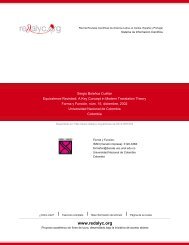Portraits of the spiritual Seeing in Mark's Gospel. Origen ... - Redalyc
Portraits of the spiritual Seeing in Mark's Gospel. Origen ... - Redalyc
Portraits of the spiritual Seeing in Mark's Gospel. Origen ... - Redalyc
Create successful ePaper yourself
Turn your PDF publications into a flip-book with our unique Google optimized e-Paper software.
Jesus and <strong>the</strong> Demons:...<br />
327<br />
40. This episode is worth mention<strong>in</strong>g to <strong>the</strong> present topic because it<br />
shows one <strong>of</strong> <strong>the</strong> two occurrences <strong>of</strong> <strong>the</strong> verb <strong>the</strong>ōréō hav<strong>in</strong>g Jesus as its<br />
subject. The o<strong>the</strong>r <strong>in</strong>stance is Mark 5:38, where is narrated <strong>the</strong> rais<strong>in</strong>g<br />
<strong>of</strong> Jairus’ daughter. The pericope states that on arriv<strong>in</strong>g to <strong>the</strong> <strong>of</strong>ficial’s<br />
house, Jesus observes/contemplates (<strong>the</strong>ōrei) <strong>the</strong> commotion <strong>of</strong> <strong>the</strong><br />
people. His contemplation goes through <strong>the</strong> real funeral laments, pro<strong>of</strong><br />
<strong>of</strong> <strong>the</strong> fatality <strong>of</strong> death, to perceive that death is not <strong>the</strong> end, but <strong>the</strong><br />
opportunity for a new gift <strong>of</strong> life that comes from God 43 .<br />
Talk<strong>in</strong>g about <strong>the</strong> poor widow’s episode, Mark sets it <strong>in</strong> <strong>the</strong> second<br />
Temple which its entire enclosure had eight gates: two on <strong>the</strong> South,<br />
four on <strong>the</strong> West, one on <strong>the</strong> North, and one on <strong>the</strong> East. The enclosed<br />
space was divided <strong>in</strong>to several courts. The largest one was <strong>the</strong> court <strong>of</strong><br />
<strong>the</strong> Gentiles, where everyone could have access to; it was separated from<br />
<strong>the</strong> o<strong>the</strong>r spaces by a balustrade prohibit<strong>in</strong>g <strong>the</strong> Gentiles to pass to <strong>the</strong><br />
o<strong>the</strong>r courts. Subsequently, follows <strong>the</strong> court <strong>of</strong> <strong>the</strong> women that was five<br />
steps above <strong>the</strong> court <strong>of</strong> <strong>the</strong> Gentiles; <strong>the</strong> women could not pass beyond<br />
this area. The next court was <strong>of</strong> Israel, or court <strong>of</strong> <strong>the</strong> men, followed<br />
by <strong>the</strong> court <strong>of</strong> <strong>the</strong> priests, and <strong>the</strong>n <strong>the</strong> Holy <strong>of</strong> Holies or Sanctus<br />
Sanctorum 44 . Jesus was sitt<strong>in</strong>g down <strong>in</strong> <strong>the</strong> court <strong>of</strong> <strong>the</strong> women, aga<strong>in</strong>st<br />
one <strong>of</strong> <strong>the</strong> thirteen treasury boxes (gazophylákion), contemplat<strong>in</strong>g<br />
(e<strong>the</strong>ōrei) everyone giv<strong>in</strong>g <strong>the</strong>ir <strong>of</strong>fer<strong>in</strong>g. It is crucial to highlight <strong>the</strong><br />
tense <strong>of</strong> <strong>the</strong> verb <strong>the</strong>ōréō that is <strong>in</strong> <strong>the</strong> imperfect <strong>in</strong>dicative form: e<strong>the</strong>ōrei.<br />
The verbal aspect <strong>in</strong>dicates an action <strong>in</strong> progress <strong>in</strong> <strong>the</strong> past that is not<br />
f<strong>in</strong>alized yet or completed 45 , so «Jesus was contemplat<strong>in</strong>g». In this case<br />
it would not be appropriate to translate «he beheld» (ASV, DRA, ETH,<br />
GNV, KJV) 46 , or «he observed» (NAB, NJB, ESV, CJB) 47 , given that<br />
would be <strong>the</strong> proper render<strong>in</strong>g <strong>of</strong> an aorist. However, <strong>the</strong> Greek text is<br />
clearly an imperfect <strong>in</strong>dicative signify<strong>in</strong>g an action <strong>in</strong> progress as it is<br />
43<br />
Cf. R. Pesch, Il vangelo di Marco: Parte prima. Testo greco e traduzione (Brescia<br />
1980) I, 486-487.<br />
44<br />
Cf. J. McKenzie, «Temple», Dictionnaire de la Bible, 875-876.<br />
45<br />
Cf. Wallace: 541.543; Blass-Debrunner: n. 325. 327.<br />
46<br />
ASV: American Standard Version (1901); DRA: Douay-Rheims 1899 American<br />
Edition; ETH: E<strong>the</strong>ridge translation <strong>of</strong> <strong>the</strong> NT Peshitta (1849); GNV: Geneva<br />
Bible (1599); KJV: K<strong>in</strong>g James Version (1611, 1769).<br />
47<br />
NAB: New American Bible (1970, 1986, 1991, 2010); NJB: New Jerusalem Bible<br />
(1985); ESV: English Standard Version (2001,2007,2011); CJB: Complete Jewish<br />
Bible (1998).
















